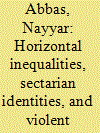| Srl | Item |
| 1 |
ID:
144460


|
|
|
|
|
| Summary/Abstract |
Why are large population movements conflict-prone in some regions while they remain peacefully integrated elsewhere? I argue that clashes between ethnically distinct indigenous populations and migrants – i.e. ‘Sons of the Soil (SoS) conflict’ – erupt when there are large socio-economic and political horizontal inequalities between ‘dominant migrants’ and locals. A comparative case study of two Chinese minority regions based on ethnographic fieldwork and population data provides a vivid illustration of the mechanisms linking migration to SoS conflict. With fewer HIs between migrants and locals, Inner Mongolia avoided many of the violent clashes that were commonplace in Qinghai, a province fraught with disparities.
|
|
|
|
|
|
|
|
|
|
|
|
|
|
|
|
| 2 |
ID:
190090


|
|
|
|
|
| Summary/Abstract |
Sectarian-based violent extremism has long been a security concern for the Government of Pakistan. Despite the perseverance of state authorities in countering violent extremism, a discourse centered on horizontal inequalities as the determinant of violent extremism and conflict remains lacking. This paper highlights the importance of an empirical study in understanding the nexus between horizontal inequalities and sectarian-based violent extremism in Gilgit-Baltistan (GB). By analyzing the responses from Shia and Sunni sectarian identities, the study contextualizes violent conflict and elucidates how horizontal inequalities intersect with sectarian identities in the capital city of GB. In doing so, socioeconomic and cultural inequalities have been evaluated. The study relies on a multistage random sample of 212 respondents through a structured questionnaire. The findings reflect significant socioeconomic inequalities between the sectarian identities and suggest a linear relationship in which horizontal inequalities generate identity-driven “us” vs “them.”
|
|
|
|
|
|
|
|
|
|
|
|
|
|
|
|
| 3 |
ID:
144863


|
|
|
|
|
| Summary/Abstract |
Although past scholarship shows that group inequalities in economic and political power (“Horizontal Inequalities”) correlate with dissent, violence, and civil wars, there is no direct empirical test of the perceptual explanation for this relationship at the individual level. Such explanation is vital to understanding how integration, inclusion in power-sharing agreements, and exclusion from political power filter down to mass publics. Moreover, subjective perceptions of group conditions do not always correspond to objective group realities. We hypothesize subjective perceptions attenuate the effect of objective exclusion on support for violence in ethnically divided societies. Cross-national comparative multilevel analyses of the 2005/6 Afrobarometer dataset (N = 19,278) confirm that subjective perceptions both amplify the effect of exclusion on acceptance of violence and alter the readiness of included groups to dissent. These findings carry implications for research, state-building, and conflict management.
|
|
|
|
|
|
|
|
|
|
|
|
|
|
|
|